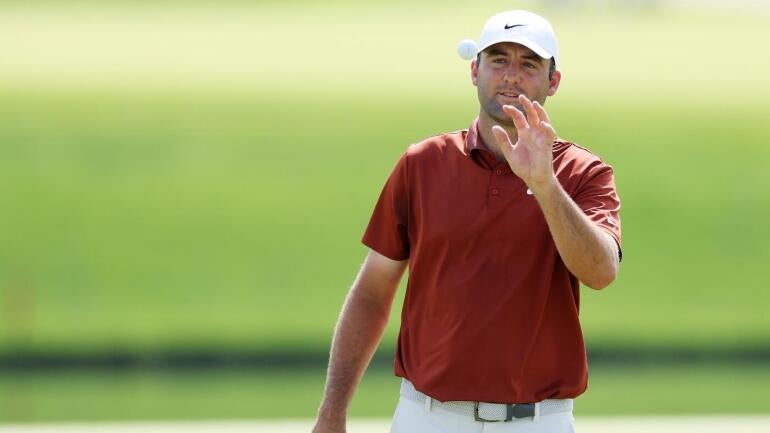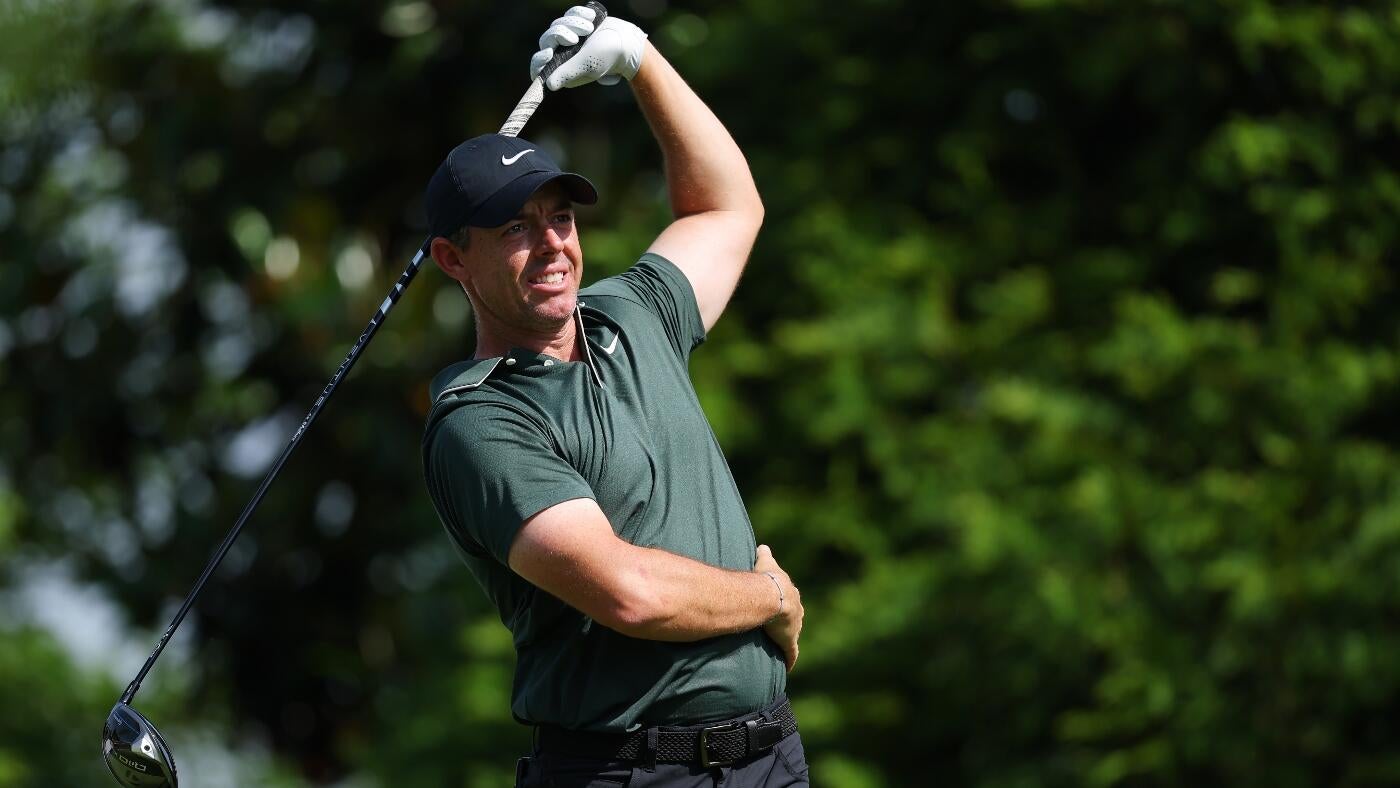

One of the big stories early in the week was the rain that poured on Quail Hollow Club on Monday and Tuesday, soaking the golf course and leading to questions about how it would play once the tournament began.
We got our answer on Thursday morning in ideal weather conditions as the course still had plenty of teeth thanks to some incredibly firm greens despite the rain. The soft fairways also created a unique challenge as well, as players had to deal with mud balls at times since the PGA announced they were not going to play “preferred lies” in the fairway, which allows players to clean mud off of their golf ball and place it back in the fairway within a club length of their original shot, no closer to the hole.
After they finished their first round on Thursday morning, Scottie Scheffler and Xander Schauffele both expressed their frustration with playing the ball down this week, and it figures to be a story throughout the championship.
What is a mud ball and what does it impact?
A mud ball is exactly what it sounds like — when mud gets stuck to the golf ball. This can happen when the ground is soft and muddy underneath the turf; the ball will go through the grass layer of the fairway and pick up some mud as it bounces.
As for what a mud ball does, the biggest challenge is the uncertainty. It’s impossible to know on any given shot how it will impact it. Sometimes, the mud will fly off almost immediately after contact and the ball will then react as it normally would on a shot. Other times, the mud will impact the ball flight dramatically by staying on one side and effectively pushing it one way or the other with spin.
That makes it incredibly difficult to plan for the mud, even when you notice it on one side or the other, because if you aim for the mud to force it left or right and then it just goes straight, you can be in as much trouble as if the mud does shove it one way or another. That is why Schauffele and Scheffler were both frustrated after their round, as they were both the victims of mud balls on the 16th hole; they each had an iron from the fairway snap left and bound into the water leading to double bogeys.

What’s the argument from Scheffler, Schauffele?
Scottie Scheffler is not a man who gives long answers often at the press conference podium, but when asked about the issue, he gave a long and detailed answer about why he thinks they should be playing preferred lies and what he thinks the argument against them is missing or ignoring.
“I think when you’re looking at the purist forms of golf, like if you’re going to go play links golf, there’s absolutely no reason on a links golf course you should play the ball up. It doesn’t matter how much rain they get. The course could be flooded under water and the ball is still going to bounce somehow because of the way the turf is and the ground underneath the turf.
In American golf, it’s significantly different. When you have overseeded fairways that are not sand-capped, there’s going to be a lot of mud on the ball, and that’s just part of it. When you think about the purest test of golf, I don’t personally think that hitting the ball in the middle of the fairway you should get punished for.
On a golf course as good of conditioned as this one is, this is probably a situation in which it would be the least likely difference in playing it up because most of the lies you get out here are all really good. So I understand how a golf purist would be, oh, play it as it lies. But I don’t think they understand what it’s like literally working your entire life to learn how to hit a golf ball and control it and hit shots and control distance, and all of a sudden due to a rules decision that is completely taken away from us by chance.
In golf, there’s enough luck throughout a 72-hole tournament that I don’t think the story should be whether or not the ball is played up or down. When I look at golf tournaments, I want the purest, fairest test of golf, and in my opinion maybe the ball today should have been played up.
But like I said, I don’t make the rules. I deal with what the rules decisions are. I could have let that bother me today when you got a mud ball and it cost me a couple shots. It cost me possibly two shots on one hole, and if I let that bother me, it could cost me five shots the rest of the round. But today I was proud of how I stayed in there, didn’t let it get to me and was able to play some solid golf on a day in which I was a bit all over the place and still post a score.”
The best argument in this, to me, is about the way courses are set up and the kinds of grass they play on. Scheffler is right to note that the idea of playing it as it lies started in links golf where the turf is always firm and sandy and there isn’t mud to kick up no matter the rain. The overseeded grass at Quail Hollow is lush and green, which is the aesthetic preferred by American courses, but does mean the layer underneath is going to be muddy when it’s wet and the ball will pick that up.
Schauffele, for his part, didn’t go into a lengthy diatribe on golf course agronomy, but simply noted that it’s going to get worse as the week goes on because it’s really the days when the course starts drying out that the mud pick up is the worst.
“The mud balls are going to get worse,” Schauffele explained. “They’re going to get worse as the place dries up. They’re going to get in that perfect cake zone where it’s kind of muddy underneath and then picking up mud on the way through. I mean, you just keep — I don’t know, maybe hit it a little bit lower off the tee, but then unfortunately the problem with hitting it low off the tee is the ball doesn’t carry or roll anywhere, so then you sacrifice distance. It’s a bit of a crapshoot.”
He’s not wrong; right now it’s wet enough that a lot of the mud doesn’t “cake” as he puts it and is more splattery and isn’t quite as impactful. That’s why this issue isn’t going anywhere and it’s going to be a discussion point all week.
Why isn’t the PGA playing preferred lies?
Preferred lies are, well, let’s call it a contentious issue within the golf world. Players, of course, want them because it takes one of the most chaotic and unpredictable variables out of play. A number of fans and purists would argue that playing the ball up (another term for preferred lies) is against the spirit of the game — playing the ball as it lies is so foundational to the sport of golf.
While we often see preferred lies in regular PGA Tour events after heavy rains, the majors have a pretty staunch policy of not playing them. The only time they have been played is the 2016 PGA Championship final round at Baltusrol. On Wednesday, the PGA announced they would not go to them, citing the quality of the course and how quickly it’s drying out.
So, what should we expect the rest of the week?
I don’t foresee the PGA changing course on this issue given their statement on Wednesday, so what you can expect is to hear the phrase “mud ball” a ton. Players will yell it after wayward shots, commentators will point it out when they see it on balls in the fairway and we just might get one in a particularly big moment on the weekend.
The argument on the player side is understandable. No one wants to be doing something incredibly important and to have forces outside of their control potentially impact the outcome. I think the point about getting punished for hitting a great shot is poignant from Scheffler; it only really happens in the fairway because shots into the rough aren’t going to go through thick grass to get to the wet mud underneath.
However … that’s also golf. Sometimes you get a bad-weather draw and have to deal with worse conditions because of a tee time. Sometimes you get gusted by wind right as you hit the ball. And sometimes you have mud balls. Everyone will deal with them some of the time, and as Scheffler noted when talking about how proud he was of the way he stayed in it and closed strong to post a 2-under 69, it will further test the mental fortitude of the field.
Handling a bad break is part of what is required to win a major championship. This week it doesn’t appear the weather will be actively impacting players, but instead we’ll see the lingering effects in the form of mud balls. Battling through that and staying in your process will be paramount to success, and that’s going to be part of the challenge in trying to win this week.
This news was originally published on this post .







Be the first to leave a comment